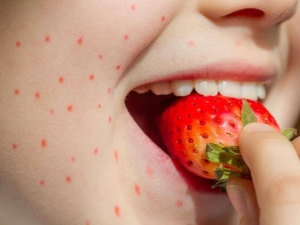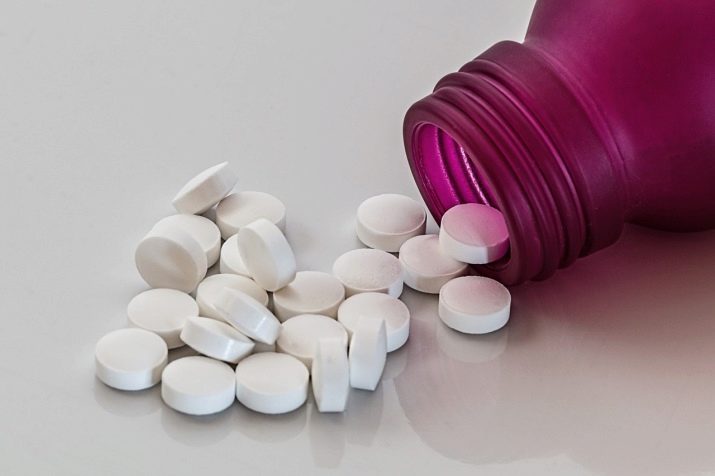Strawberry allergy: causes, symptoms and treatment

Strawberry is an attractive, tasty and very healthy berry, which is enjoyed by adults and children.It carries an abundance of nutrients and vitamins, and also has a pleasant sweet-sour taste. However, sometimes a useful delicacy can lead to very undesirable consequences. Allergy - this phenomenon is not only unpleasant, but also harmful, and in severe cases, very dangerous to human health.
Possible causes of allergies
In the modern world, where the allergen environment prevails, there are more and more people suffering from allergies to various substances. The immune system begins to fight alien (often non-dangerous) proteins, producing histamines, and an allergic reaction occurs.
Although not all people are prone to hyperreaction, there is a certain group of people with a range of risk factors that increase the likelihood of developing allergies:
- genetic predisposition;
- severe illness when the immune system is not yet strong;
- during periods of hormonal adjustment of the body (puberty, menopause, pregnancy and breastfeeding);
- severe nervous exhaustion and stress.
Allergy, which appeared in childhood, can fade away by the time of maturation. However, the above reasons are not the only ones. Below we look at what exactly can be an allergic reaction when eating strawberries.
Substances in the composition of the berries
- The main reason is the protein that is responsible for the red color of the fruit. If the reason is the color, allergy to red foods, then instead of the usual strawberries you can eat white or yellow varieties.
- Along with the true allergies, there is a pseudo-allergy, the development of which is due to overeating and an excess of strawberry protein in a healthy body.
- Substances that make up the berries: residues of galacturonic acid, essential oils, vegetable polyphenols. Substances that make up the leaves and flowers: vegetable polyphenols, glycosides.
- Unripe fruits are rich in phytoalexins: substances protect the berry, but in humans can cause photosensitive dermatitis.
- Due to the specific porous structure, plant pollen accumulates on the surface of the fruit - one of the strongest allergens.
These substances can provoke a reaction of the body.
It is important to note that the same components are present in cosmetics with strawberry extract and various decoctions of twigs, leaves and flowers.
The result of processing chemicals
All berries, vegetables and fruits are sprayed with special chemicals that can cause allergies. These are solutions that increase the rate of growth and maturation of the plant, shelf life and storage. Contact allergies are often caused by substances used to protect the plant from pests and diseases.
Experts recommend buying a berry only during its maturation: the summer period from mid-June. Out-of-season strawberries have significant pesticide contamination.
Symptoms
Red berry allergy can be of several types.
- Contact The reaction appears immediately after tactile contact with the berry or the plant itself.
- Food. The most common type that occurs after direct consumption of food.
- Cross. The peculiarity of such an allergy is that sensitivity to strawberry protein causes susceptibility to other products with a similar protein in the composition. Accordingly, an allergy to the pollen of some plants - grapes and its products, members of the pink family - can provoke an acute reaction to strawberries.
Of course, the child signs appear faster and harder, due to the instability and immaturity of the body. However, they are the same in children and adults.
- The defeat of the skin. The skin acquires a rich red color, it becomes either very dry, or gets wet, which looks like prickly heat. Severe itching begins, small blisters sometimes form.Tender skin areas are most affected: the face, back, hair growth area, armpits, groin and thin skin on the hands and feet. In severe form, the nasolabial triangle, throat and larynx tissues swell, which can lead to difficulty in breathing.
- The defeat of the respiratory system. Depending on the severity, the upper or lower airways are affected. Upper: allergic rhinitis develops (runny nose, profuse watery discharge, maceration of the skin under the nose), swallowing is accompanied by a slight sore throat (swelling of the lips, tongue), cough. Lower: edema of the larynx and trachea (barking cough, intermittent breathing, slurred speech), edema of the bronchi, pain in the chest. This condition is extremely dangerous for health and is a threat to life.
- The defeat of the gastrointestinal tract. With a hyper reaction, the victim experiences nausea, vomiting and upset stool. In severe cases, due to severe fluid loss, dehydration develops.
- Common symptoms. A person feels unwell, headache, dizziness, body temperature rises.
- The defeat of the mucous membrane. Much of the eye is affected. They blush, swell and become inflamed. Itching begins, uncontrollable lacrimation (or, conversely, dryness and burning), sometimes suppuration.
Young children can only be given a berry after reaching two years, starting with very small portions, and it is better to replace the fresh product with heat-treated ones.
It is important to harden the body of the baby, increase the body's resistance and be sure to consult with an allergist.
It is desirable for nursing women to abandon the fresh product, since the allergen along with the mother's milk enters the body of infants. Pregnant women have their own special contraindications. So, in late pregnancy, starting from week 22, you cannot eat fresh strawberries. This is due not only to the possible reaction, due to hormonal changes, but also to certain substances that increase the tone of the uterus. The most terrible complication in this case may be premature birth. Also, the consumption of berries on this period adversely affects the fetus and can cause congenital diathesis.
Treatment
If a person has symptoms of hypersensitivity to strawberries, even in a mild form, first of all it is necessary to exclude the product from the diet and visit a certified specialist.
You can not close your eyes to these manifestations and try to get rid of allergies on their own, as you can bring the situation to a critical moment.
The attending physician, after conducting all laboratory tests, will select the optimal treatment plan for each individual.
To begin to act against this state should be immediately. After confirming the diagnosis, antihistamines are prescribed, the purpose of which is to block histamine receptors, which are the main cause of allergy.
It is not recommended to drink these medicines on your own, and even less to give them to children. Each drug has its own power of action and a list of side effects, so it is important to choose the right dosage.
For the speedy removal of an allergic reaction, quick-acting preparations are used. Taking Tavegil, Suprastin, Dimedrol, or Diazolin will reduce the soft tissue swelling and ease breathing after 10–15 minutes, which is important in developing anaphylactic shock, angioedema and generalized urticaria. Side effects: weakness, reduced reaction and drowsiness.
With light and medium severity, most often prescribed drugs of the new generation, which begin to work more slowly, but are more delicate to the heart muscle and the central nervous system. These include Fenistil, Claritin, Aleron and Cetirizine. The drugs work for twenty-four hours, in rare moments accompanied by drowsiness.
To facilitate breathing and relieve bronchospasm, you can take a bronchodilator, for example, "Salbutamol." Sorbents are drunk to remove decay products and toxic things: they absorb harmful substances and help remove them from a weakened organism (Smekta, activated carbon, Polysorb, etc.). The affected skin is smeared with gels, ointments and creams of different groups: hormonal (Prednisolone and Hydrocortisone ointments), antihistamines (Fenistil gel, Ketocin), anti-inflammatory (Bepanten, Panthenol). For the treatment of local symptoms using oral sprays, drops, lotions, and so on.
The following useful recipes can be distinguished from traditional medicine, which not only have a beneficial effect on the body, but are also devoid of side effects.
- Tincture of the series. A series of fill with boiling water and tightly corked capacity. Insist for 30 minutes, the infusion should be saturated in color. Take need three times a day for 50 milliliters.
- To reduce skin itching, you can prepare a decoction of bay leaf. Five or six bay leaves for 30 minutes boil on fire, then let cool. In the resulting product we wet gauze napkins and apply to irritated skin.
- Homemade ointment from chicken eggs, vinegar and oil will help reduce inflammation. We mix the vinegar with the egg and incubate for 24 hours, add the butter to the mixture and put the ointment in the fridge. The composition should be applied before bedtime.
- To increase the overall resistance of the body and disinfect damaged skin areas, you can make warm baths with a strong decoction of oak bark and chamomile.
During the period of treatment it is necessary to follow a diet in order not to overload the gastrointestinal tract.
- Complete rejection of alcoholic beverages. Alcohol has the property of enhancing allergic reactions.
- Do not eat fatty, salty and fried foods.
- Sweet soda is also worth excluding.
- Reducing the number of simple carbohydrates contained in confectionery.
During this period, the use of buckwheat and rice cereals, unripe vegetables and fruits, fresh dairy products is useful.
As a preventive measure of the onset of allergies or its aggravation, it is necessary to follow some simple rules.
- Complete rejection of the berries. With a light form, you can use heat-treated strawberry dishes.
- It is necessary to limit the use of related fruits of strawberries: raspberries, strawberries, rose hips, apples, and so on.
- A healthy lifestyle will help maintain the body in good shape, strengthen the immune system and increase resistance to the allergen.
- Preventive specialist visits once every 6 months to monitor your condition.
- Introduce the fetus in the diet of the child can only be two years old.
- In the bag should always lie antihistamine drug quick-acting, to be able to stop an unexpected attack, as it is not always possible to control the composition of the purchased products.
About what to do with allergies to strawberries and other berries, you can see in the video below.


































